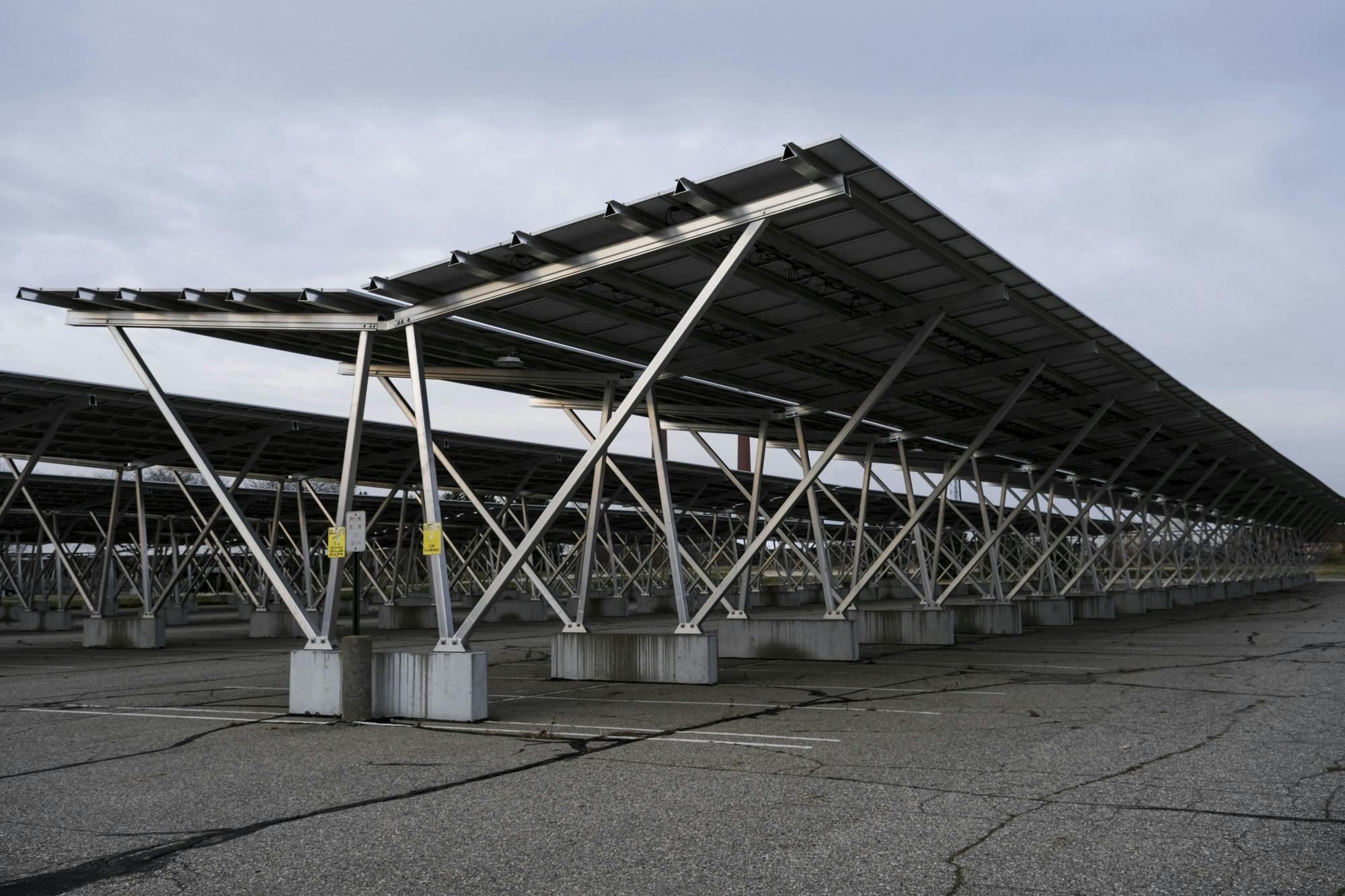Taking a step forward in sustainability, Michigan State signed a contract to establish a 110-acre, 20-megawatt solar panel array on south campus along Hagadorn Road, between Bennett Road and Jolly Road.
The contract, signed with NextEra Energy, allows for the university to purchase the electricity at a fixed rate over the agreement’s 35-year duration. In exchange, NextEra will build and maintain the array.
MSU will have the opportunity to buy the project’s assets over the course of the term, meaning that they may own the panels and related equipment once the contract expires.
Although the project is still in a planning and design phase, Infrastructure Planning and Facilities, or IPF, Communications Manager Fred Woodhams said in an email that construction will likely begin in spring 2022 and the array should be operational by December of that year, with little to no road closures in-between.
Woodhams further explained the intent of this project, which was originally announced and approved at a MSU Board of Trustees meeting in February.
“Michigan State University has ambitious sustainability goals and the new solar arrays are a big step toward further reducing MSU’s greenhouse gas emissions,” Woodhams said.
He also said that in signing the agreement, the university is being more cost-effective.
“We are expecting that this will save the university $40 million over the course of the power purchase agreement,” Woodhams said.
Woodhams also said that the array is being built in tandem with new natural gas-powered generators that can be more readily powered on and off to meet demand, given that the solar array may supply the electricity in an inconsistent fashion, dependent on the weather.
In 2012, the university created an Energy Transition Plan with the aim to transition to 100% renewable energy, while reaching 20% by 2020 and 40% by 2030. This solar array is projected to increase the average yearly electrical load sourced from renewables from 7% to nearly 20%, putting the university slightly behind on the proposed timeline.
Since then, the university has completed multiple projects in sustainability including solar carports and an anaerobic digester, both working together to supply the campus with 15 megawatts of power.
On Thursday, Sept. 16, President Samuel L. Stanley Jr. yielded questions at an Associated Students of MSU General Assembly meeting. College of Agriculture and Natural Resources representative Blake Lajiness asked Stanley about the future of sustainability at MSU. Stanley then made the GA aware of the contract for the array.
“My very first reaction was, ‘Yay, it finally happened, I’m so excited about it!,’” Lajiness said. “That really is a huge next step for the university.”
But, Lajiness said that his thoughts didn’t end there. After more consideration, he said that MSU needs to be planning ahead and hopes that the administration will listen to students more on sustainability.
“Some student organizations, as well as sustainability-minded students on campus, aren’t going to stop trying to fight for more green energy, but a ton of other things across campus as well in the sustainability realm,” Lajiness said. “My first thought is ‘Yay!’ But my second thought that comes in very shortly after is, ‘That’s great, but what’s the next step?’”
Lajiness also said that he doesn’t believe MSU is doing enough in their sustainability efforts. In saying so, he cited the university's Sustainability Tracking, Assessment & Rating System rating of Gold.
“We’re Gold status, we’re not Platinum status, and there’s that next step to get to Platinum status,” Lajiness said. “That should be our goal, among other things. There is more we can do. No, I don’t believe we’re doing enough. Yes, the things we are doing are amazing, but I think we could be doing more.”
Currently, only nine universities have a Platinum distinction, and none of them are in the Big Ten.
As far as specific initiatives that Lajiness would like to see implemented, he wants to see a full divestment from fossil fuels, a declaration of a climate emergency and increased recycling initiatives on and off-campus.
Addressing the latter two, Lajiness will introduce Bills 57-45 and 57-47 to the assembly on Thursday, Dec. 10.
Support student media!
Please consider donating to The State News and help fund the future of journalism.
In a press release issued on Feb. 14, after the Board of Trustees approved the project, Stanley said that the solar arrays will support the well-being of the MSU community.
“The sustainability of our environment goes hand in hand with the well-being of our students, faculty and staff at Michigan State,” Stanley said in the press release. “This project not only furthers MSU’s commitment to renewable energy, it also provides a cleaner future for our campus, the world and the next generation of Spartans.”
This article is part of our Women in the Workplace print issue. Read the full issue here.
Discussion
Share and discuss “MSU signs contract with NextEra Energy for 20 MW solar array” on social media.




